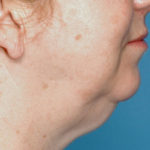One of the most straightforward and most satisfying procedures is plastic surgery is chin augmentation. Enhancement of the deficient chin can make a dramatic difference in one’s facial profile. Like the nose, although not as well appreciated, the position of the chin not only plays an important role on the silhouette of the face and neck but helps form an impression (accurate or not) on one’s character.
A well-defined chin that is in proportion to the rest of the face suggests strong character traits and portrays an image of strength. Conversely, a recessed or weaker chin can cast quite the opposite image.
The decision (need) to perform chin augmentation is dependent on an assessment of the chin as it sits relative to the rest of the face. This is done exclusively by a profile assessment where a straight line is dropped down from the junction of the nose and forehead with the face looking straight forward and as level as possible. Where the most projecting point of the chin rests relative to this vertical line determines whether chin augmentation is beneficial, and how much, to one’s facial profile. If it rests anywhere behind this line, then chin augmentation will be helpful. How much it sits behind this line in millimeters also helps one choose the amount the chin must be brought forward. This number determines the thickness in millimeters of the chin implant or how much the chin bone must be advanced.

Complications from chin implants are quite few. The most common would be implant asymmetry but I avoid this problem by using a small screw to hold the implant in proper position so it can never move after surgery. Implant shifting around the pocket is the cause of this complication. Bleeding and infection, while possible, I have yet to see. Sometimes, the chin and lower lip will ‘move funny’ for awhile afterwards due to temporary swelling and the muscel being manipulated. In other words, the chin area will seem quite stiff after surgery which does impact on how the lower lip may move. This is a self-solving problem as the swelling goes away.
Dr. Barry Eppley
Indianapolis, Indiana



